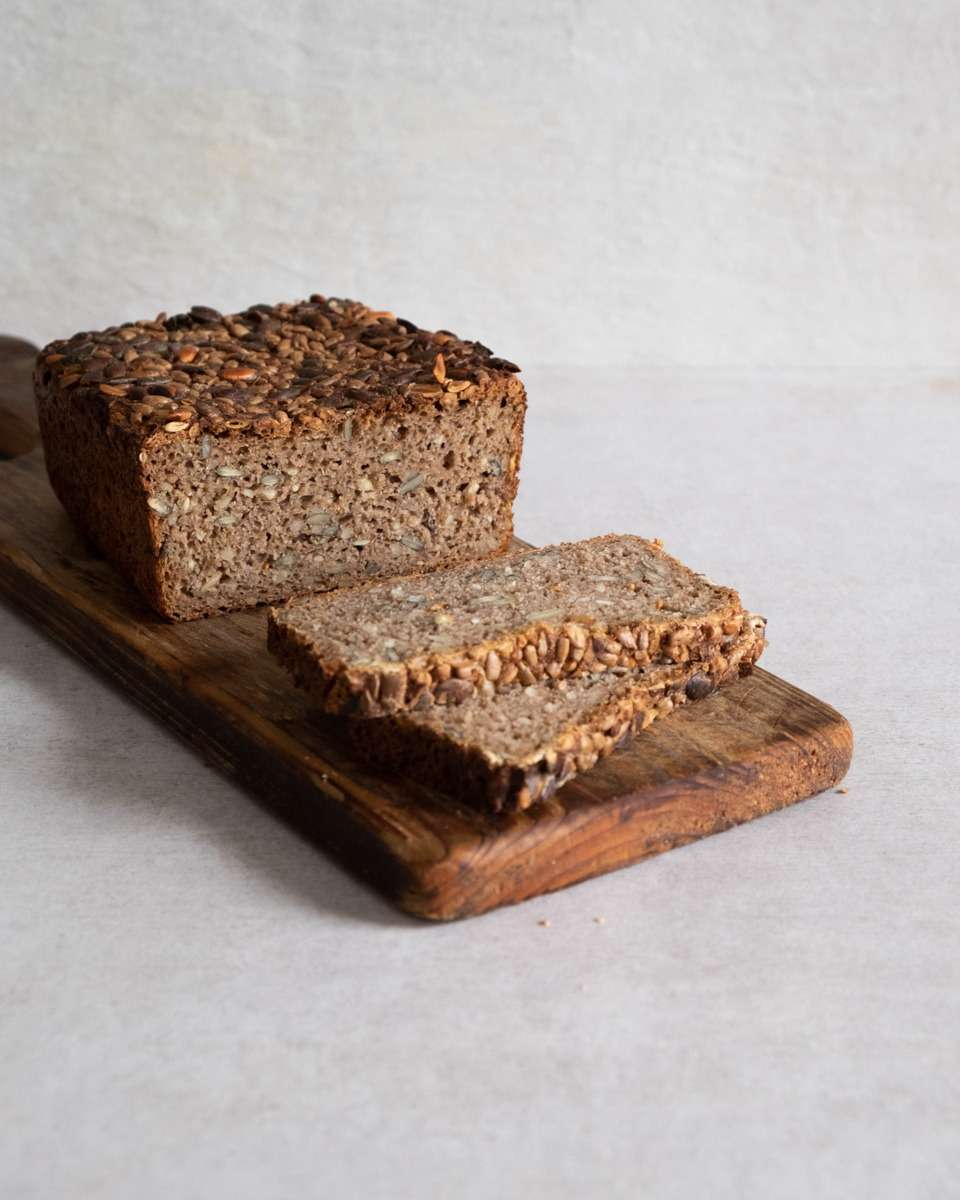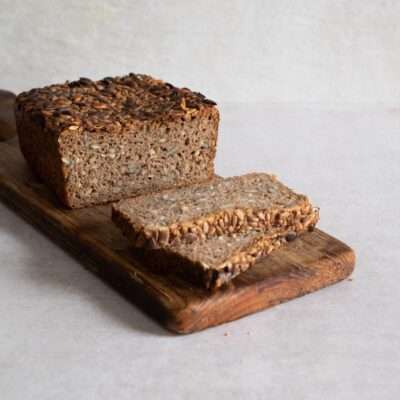Easy Sourdough Seeded Rye Bread

About Rye Bread
Being raised in Germany, seeded rye bread, or Vollkornbrot/Roggenbrot, has always been a common sight at local bakeries. But growing up a fussy eater, I’ve never given it the credit it deserves. Dark rye flour is rich in minerals, vitamins, and fibre and gives a deep, nutty flavour to the entire loaf. Pair this seeded rye bread with scrambled tofu, homemade jam, or your favorite spread, and you’ll quite quickly find rye bread becoming a staple in your home. If you have your own sourdough starter, it’s also surprisingly easy to make yourself. I first learned how to bake this bread through the wonderful E5 Bakehouse in East London. After a few changes and simplifications (but still very much inspired by their reliable recipe), I now arrived at the formula for a bread that makes a weekly appearance on my breakfast table.
Before you start
If you haven’t baked with sourdough yet, I’d recommend starting with my Sourdough Starter & Country Loaf recipe first. The step-by-step guide takes you through the process of creating your own starter through to baking your first bread. But even if you are familiar with sourdough cultures, there are a few things to note.
Rye flour develops far less gluten than wheat flour and therefore misses the support of the gluten chains to hold the structure. That’s why this recipe uses a loaf pan to give shape to the bread. Rye flour is also extremely high in nutrients that are accessible to the micro-organisms, which means the dough will ferment much faster than common wheat doughs. Lastly, rye flour absorbs more water than wholemeal wheat or bread flour. If you’d like to substitute the flour in this recipe, start with 100g less water and add more until you reach a moist yet pliable consistency.
Baking the bread
Professional bakeries have the ability to inject steam into the oven, which creates an environment in which the surface of the dough doesn’t darken considerably until the steam is removed so that the color of the crust reaches its ideal point when the bread is baked through. For our seeded rye bread, we therefore add a tray of water to the lower rack inside the oven as it pre-heats, so that the evaporating water generates steam for the first half of the bake. Bear in mind that fan settings extract the steam, so a conventional setting is preferred for this method.
Because rye flour absorbs plenty of water, seeded rye bread can seem quite moist. Always leave it to cool for 12 hours before slicing it. I won’t judge if you can’t wait that long, but you’ll notice that some of the dough might stick to the knife.
Lastly, if you’re struggling to loosen the bread from the tin, let it sit for 10-15 minutes after baking. The residue heat and oils will help it to sweat loose. Then gently go around the sides with a butter knife until you can lift out the bread.
Baking your Seeded Rye Bread
Ingredients
For the leaven
-
-
25g starter
-
125g flour mix (see Sourdough Starter and Country Loaf)
-
125g water
-
For the seeded rye bread
-
-
450g lukewarm water
-
500g rye flour
-
12g salt
-
80g pumpkin seeds +20g extra
-
80g sunflower seeds +20g extra
-
Extra virgin olive oil
-
Method
6-12 hours before mixing your dough, make your leaven by mixing 25g of your starter with 125g of the flour mix and 125g of cold water.
Dissolve 250g of the leaven in the water (use the rest to feed your starter). Add all of the remaining ingredients apart from the extra seeds. Mix thoroughly.
Grease a loaf pan (3 lb) with olive oil. With wet hands, lift out the dough and shape it into an oval form, before placing it into the tin.
Press it down to flatten the surface. Sprinkle the remaining seeds on top and press them in slightly. Then cover the tin with a clean tea towel and proof the dough at room temperature until doubled in size (around 4-6 hours).
Place a tray filled with water on the bottom of the oven and preheat to 250° C (230° C fan).
Bake the loaf for 25 min. Decrease the temperature to 220° C (200° C fan), carefully remove the tray with water and bake for another 25 min. Let it cool for 12 hours before slicing.

Sourdough Seeded Rye Bread
Ingredients
For the leaven
- 25 g starter
- 125 g flour mix (see Sourdough Starter and Country Loaf)
- 125 g water
For the bread
- 450 g lukewarm water
- 500 g rye flour
- 12 g salt
- 80 g pumpkin seeds + 20g extra
- 80 g sunflower seeds + 20g extra
- extra virgin olive oil
Instructions
- 6-12 hours before mixing your dough, make your leaven by mixing 25g of your starter with 125g of the flour mix and 125g cold water.
- Dissolve 250g of the leaven in the water (use the rest to feed your starter). Add all of the remaining ingredients apart from the extra seeds. Mix thoroughly.
- Grease a loaf pan (3 lb) with olive oil. With wet hands, lift out the dough and shape it into an oval form, before placing it into the tin.
- Press it down to flatten the surface. Sprinkle the remaining seeds on top and press them in slightly. Then cover the tin with a clean tea towel and proof the dough at room temperature until doubled in size (around 4-6 hours).
- Place a tray filled with water on the bottom of the oven and pre-heat to 250° C (230° C fan).
- Bake the loaf for 25 min. Decrease the temperature to 220° C (200° C fan), carefully remove the tray with water and bake for another 25 min. Let it cool for 12 hours before slicing.
Video
@bakinghermann Let’s make a sourdough rye bread ???? #sourdough #ryebread #tiktokfood #sourdoughbread ♬ original sound - Julius Fiedler

Such an incredible recipe. The flavour is so good and the recipe is so simple. I added walnuts to mine as well and it worked great. I had tried non-sourdough recipes for this style of bread but the flavour wasn’t it. This a great recipe if you’re new to sourdough as well! Thanks for the recipe, I’m going to go make another loaf!
Amazing! It’s still my go-to loaf today! Very hands-off, but extremely rewarding. Great idea with the walnuts!
This is the easiest and tastiest rye bread I’ve ever made. It’s my go to bread because of how simple and straightforward it is to make.
It’s dense and somewhat sour, but well balanced with the seeds. I like to substitute the pumpkin seeds for whole flaxseeds because it’s what I have on hand. Truly so good!
I’m so glad you like it so much! This is also still my go-to rye bread. I always bake two big loaves and keep the sliced bread in the freezer, ready to be toasted whenever I feel like. And exactly, just use whatever seeds you have on hand!
Hey,
Thanks a lot for the recipe. I have been making this a few times now! However I had a few questions:
– what rye flour are you using exactly? I am in Germany. Does It have to be wholegrain or an in between?
– what kind of heating are you using on the oven? Turning or under/over heat?
Thanks so much again !